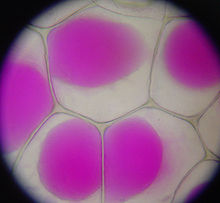Lysis: Difference between revisions
m robot Adding: sv:Lysering |
Gintautasm (talk | contribs) |
||
| Line 5: | Line 5: | ||
==Applications== |
==Applications== |
||
Cell lysis(splitting of cells) is used mostly in [[western blotting]] to analyze the composition of specific [[proteins]], [[lipids]] and [[nucleic acids]] individually or as [[complexes]]. Depending upon the [[detergent]] that is used either all [[membranes]] are lysed or certain membranes are lysed, leaving other membranes intact. For example if the [[cell membrane]] only is lysed then [[gradient centrifugation]] can be used to collect certain [[organelle]]s - [[Cell nucleus| microscopy]] or [[western blotting]]. |
Cell lysis (splitting of cells) is used mostly in [[western blotting]] to analyze the composition of specific [[proteins]], [[lipids]] and [[nucleic acids]] individually or as [[complexes]]. Depending upon the [[detergent]] that is used either all [[membranes]] are lysed or certain membranes are lysed, leaving other membranes intact. For example if the [[cell membrane]] only is lysed then [[gradient centrifugation]] can be used to collect certain [[organelle]]s - [[Cell nucleus| microscopy]] or [[western blotting]]. |
||
==Cytolysis== |
==Cytolysis== |
||
Revision as of 19:36, 2 January 2009
Lysis (Greek λύσις, lysis from lyein = to separate) refers to the death of a cell by breaking of the cellular membrane, often by viral or osmotic mechanisms that compromise its integrity. A solution containing the contents of lysed cells is called a "lysate".
Applications
Cell lysis (splitting of cells) is used mostly in western blotting to analyze the composition of specific proteins, lipids and nucleic acids individually or as complexes. Depending upon the detergent that is used either all membranes are lysed or certain membranes are lysed, leaving other membranes intact. For example if the cell membrane only is lysed then gradient centrifugation can be used to collect certain organelles - microscopy or western blotting.
Cytolysis

Cytolysis is the lysis of cells in a hypotonic environment. Cytolysis is caused by excessive osmosis, or movement of water, towards the inside of a cell (hyperhydration). The cell membrane cannot withstand the osmotic pressure of the water inside, and so it explodes. Osmosis occurs from a region of high water potential to a region of low water potential passing through a semipermeable membrane, so these bursting cells are located in hypotonic environments.
Cytolysis can be prevented by several different mechanisms, including the contractile vacuole that exists in some paramecia which rapidly pump water out of the cell.
Cytolysis does not occur under normal conditions in plant cells because plant cells have a strong cell wall that contains the osmotic pressure, or turgor pressure, that would otherwise cause cytolysis to occur.
Plasmolysis

Plasmolysis is the contraction of cells within plants due to the loss of water through osmosis. In a hypertonic environment, the cell membrane peels off of the cell wall and the vacuole collapses. These cells will eventually wilt and die unless the flow of water caused by osmosis can stop the contraction of the cell membrane.[1]
References
- ^ "Wiley InterScience :: JOURNALS :: New Phytologist". www3.interscience.wiley.com. Retrieved 2008-09-11.
